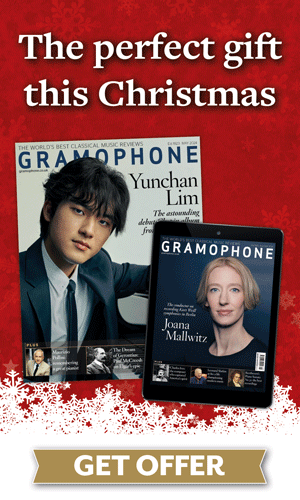Review - The Complete Symphonic, Concertante & Sacred Music Recordings (Orch dell’Accademia Nazionale di Santa Cecilia / Antonio Pappano)
Richard Bratby
Friday, September 6, 2024
Richard Bratby charts the relationship between the conductor and his Italian orchestra

In his recent memoir My Life in Music (7/24), Sir Antonio Pappano describes the process that led him to become music director of the Orchestra dell’Accademia Nazionale di Santa Cecilia in Rome, in 2005. It reads as if, even two decades on, he still can’t believe his luck. ‘It all somehow clicked,’ he writes. ‘A symphony orchestra! A dream come true, and in Italy.’ Pappano built his career in opera houses – he was already MD of the Royal Opera – but this was his first time in a top job in the concert hall, and his first permanent role in the land of his parents’ birth. The sense of glee is unmistakable: a conductor and his orchestra about to set out on a joint adventure.
Well, here we are in 2024. Pappano stood down in Rome in July 2023, and if there’s a single quality that defines this 27‑disc set, it’s that sense of shared adventure, though perhaps that suggests uncertainty. Far from it, though there are surprises here, for sure – who, before Pappano, would have dreamed of recording a Bernstein symphony cycle or a Britten War Requiem with an Italian orchestra? But there’s a feeling, right from the outset (a big-hearted recital disc, built around the Lalo Concerto, with cellist Han-Na Chang) of an orchestra and a conductor on the same page: of Pappano’s joy in discovering just how far he can take this virtuoso ensemble, and the players’ boundless, unforced enthusiasm to follow where he leads. Let’s call it an 18-year honeymoon.
There’s a feeling of Pappano’s joy in discovering just how far he can take this ensemble
It certainly sounds like one. Take Bruckner, for example, whose Eighth Symphony (the Haas version) – recorded live (like many of the recordings in this collection) in 2019 – is released for the first time in this set. Pappano describes in the booklet how he and his players bonded around this work, finding an entry point to Bruckner’s world through their shared Catholic spirituality, and you don’t have to be a committed Bruckner collector to hear that this is a performance with a voice of its own.
It’s by no means a hasty reading: at 81 minutes, it’s closer in overall length to Karajan than to Solti. But it never feels stolid or static. Pappano’s opera house experience gives him a powerful command of long-range pace, and a vivid way of characterising a melody: song-themes really sing. There’s space as well as momentum, and – particularly noticeable – a tender and intensely inward (you might call it prayerful) softness to the quieter passages that charges the whole reading with an intimacy and a sincerity that I found very moving. The horns in the Trio section of the Scherzo have a warm Alpine glow; the harp is bright but wonderfully delicate. It’s not the last word on the Eighth (what is?) but it’s Pappano’s and the OANSC’s own word; distinctive and utterly heartfelt.
It’s also a noble showcase for the special character and sound of the orchestra, something that seems to have remained consistent (if growing in refinement and daring) throughout Pappano’s tenure. Toned, shapely muscles lie beneath the sun-kissed sheen of the string sound, while the brass section is weighted towards the bottom – satisfyingly dense and dark, topped with trumpets that are bright without being blatant. And the OANSC has the most engaging woodwind section imaginable: tangy, slim-toned oboes, flutes and clarinets that melt sweetly on the tongue and (it’s surprising what a difference this makes) an irresistibly characterful principal bassoon.
Above all, there’s a collective verve; a sense of moving and phrasing together. It’s never wise to fall back on clichés about Italy and the bel canto style, but the OANSC, across the board, does have a definite instinct for letting a melody breathe and sing without any loss of forward movement. It’s on display, abundantly, in their multicoloured Mahler Sixth, as well as their surging, sunlit Heldenleben – this is a hero who really dances, with a remarkably aristocratic consort in the solo violin of concertmaster Roberto González-Monjas. (Strauss, a Bavarian, would surely have approved.)
And it makes this team particularly compelling in Slavic music. There’s a fervent, richly dramatic trilogy of the late Tchaikovsky symphonies, a gloriously sensual Sheherazade (recorded in 2022, with violinist Carlo Maria Parazzoli as a proud and articulate storyteller) and a sweeping Rachmaninov Second Symphony. In 1812, Pappano deploys the Accademia’s chorus, who sound remarkably Muscovite. Those luminous Roman horns and woodwinds give a real expressive intimacy to Pappano’s weighty, suitably epic readings of Dvo∑ák’s New World Symphony and Cello Concerto (with Mario Brunello, lean-toned and ardent); savour the expressive vibrato in the famous cor anglais solo. Inquisitive as ever, Pappano records two different orchestrations (Rimsky-Korsakov’s and Vissarion Shebalin’s) of Mussorgsky’s A Night on the Bare Mountain, with equal commitment.
But cliché or not, there’s no disputing the special quality that Pappano and the OANSC bring to Italian repertoire. Respighi’s Roman Trilogy had to be done, of course – and with what sunlit bravura these players take possession of their musical birthright! This is first-class Roman home-cooking: unpretentious but effortlessly stylish, and made from the most flavoursome of ingredients.
A disc of Rossini overtures is a particular delight, a real negroni sbagliato of a collection mixed with equal parts of flamboyance, sophistication and sparkle. The coupling – an Andante e tema con variazioni with four of the orchestra’s wind players – is huge fun. In Verdi’s Requiem and Quattro Pezzi sacri as well as three large-scale choral works by Rossini (including the orchestral version of the Petite Messe solennelle) the Accademia Chorus is hard to fault on style, energy or warmth of tone, even if the recorded acoustic (in the Verdi particularly) means that words are occasionally smudged. Nor would René Pape and Rolando Villazón have been my first choice of soloists for the Verdi.
But overall, Pappano’s operatic instincts serve him well, both in the sense of theatre that he brings to works such as Rossini’s delightfully buffo-ish Messa di Gloria and in his choice of vocal soloists, who include Michael Spyres and Sara Mingardo for Rossini, Nadine Sierra in Bernstein’s Kaddish Symphony and a 21st-century dream-team of Bostridge, Hampson and Netrebko in Britten’s War Requiem.
This was one of the first passion projects that Pappano undertook in Rome, along with the Verdi and Brahms Requiems (the latter was not, sadly, captured on disc), and this taut, atmospheric account recorded in the Britten centenary year of 2013 is testament to how completely his Italian forces were willing to immerse themselves in a work far outside their historic repertoire. Richard Fairman, reviewing it in these pages, was won over by its ‘open-hearted emotion’ and the Accademia’s ‘deliciously playful’ children’s chorus. True, no one could mistake them for an English cathedral choir, but for my money the performance is all the more poignant for it.
You’ll hardly find a more energised (or colourful) Bernstein symphony cycle, either. I rather liked Josephine Barstow’s slightly arch narration in the Kaddish Symphony; others might disagree, but in The Age of Anxiety Beatrice Rana sweeps away all doubts with lucid, penetrating clarity (she’s utterly commanding in Pappano’s Prokofiev Second Piano Concerto, too). A natural accompanist, Pappano brings his whole musical self to his collaborations with his various soloists and there are some deliciously treasurable collaborations tucked away in this box.
There’s a bristling Strauss Burleske with Chamayou and, best of all (and coupled with a noble, expansive Saint-Saëns Organ Symphony) a wide-eyed, gleefully uninhibited Carnaval des animaux with Martha Argerich, no less, joining Pappano at the keyboard. Pure happiness results, not least because of the obvious enjoyment and lightly worn virtuosity of the individual members of the OANSC. You simply couldn’t ask for a more eloquent Elephant than the orchestra’s principal bass Libero Lanzilotta. This really is the music of friends.
And that’s the abiding impression of this set. There’s a generosity to everything that’s recorded here, coupled to virtuoso playing that gives the lie to the myth that 21st-century orchestras all sound the same. That even extends to the oddest disc in the box, a dolce vita-ish selection of post-war European film themes by Michel Legrand, Georges Delerue and others with pianist Alexandre Tharaud. Apparently Pappano and his Santa Cecilia forces performed Ennio Morricone’s choral music in Rome, and wouldn’t that have been worth hearing? That’s not included here, alas, but if you wanted a definitive, dewy-fresh account of his music from Cinema Paradiso – or, indeed, Francis Lai’s theme from Emmanuelle 2 – well, here it is, and you won’t hear it done with more class.
But then, there’s hardly a performance in this box that I’d hesitate to recommend to a first-time listener. The OANSC is a deeply lovable orchestra and Pappano conducts them con amore. In a crowded marketplace, you could hardly ask for more.
This article originally appeared in the October 2024 issue of Gramophone magazine. Never miss an issue – subscribe to Gramophone today










